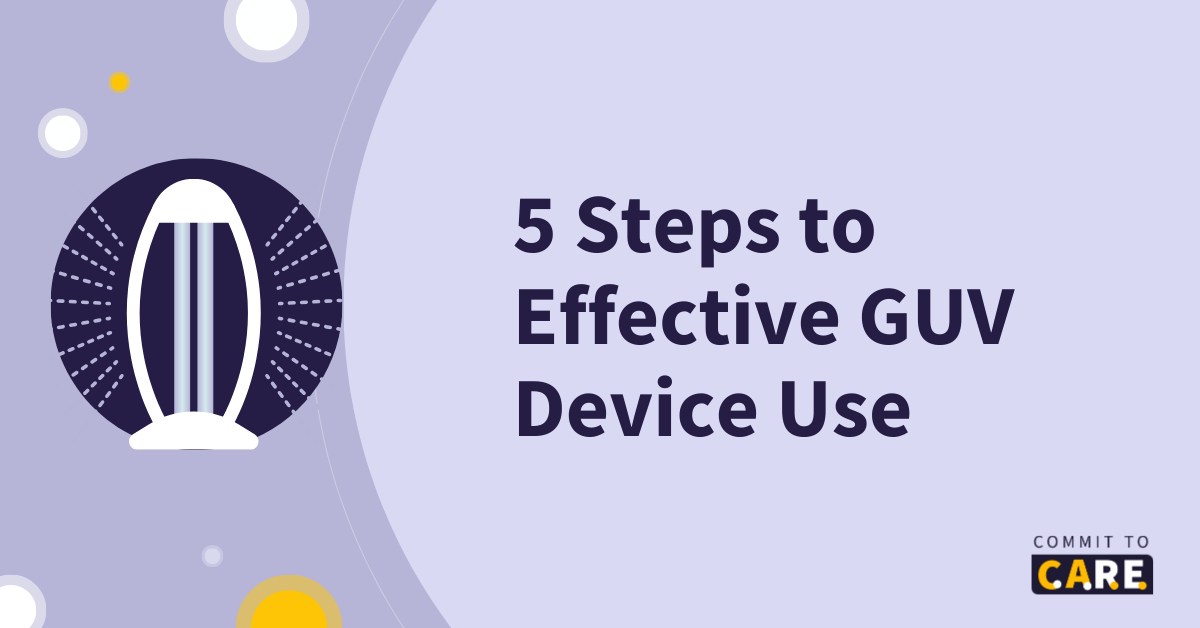5 Steps to Effective GUV Device Use

GUV (short germicidal ultraviolet) technology plays a crucial role in the strategic prevention of airborne disease transmission within indoor environments. Utilizing GUV to inactivate airborne pathogens provides a potent, non-chemical disinfection method that complements traditional air purification techniques.
Its application spans various sectors, necessitating a deep understanding of its operation and optimal usage strategies. This guide outlines five essential steps to maximize the effectiveness of your GUV device, ensuring safer indoor air quality and contributing to public health safety.
Before we dive in, it’s crucial to understand the differences between the ultraviolet spectrum’s bands: UV-A (known for causing skin aging), UV-B (known to cause sunburn and, with prolonged exposure, skin cancer), and UV-C (known to cause mild sunburn and photokeratitis lasting only a few days).
UV-C (100-280 nm) is GUV (Germicidal UV, at 200-280 nm), the most effective part of UV-C; it has the unique capability to break the DNA or RNA of microorganisms, rendering them inactive and unable to replicate. We will refer to GUV in this blog post.
Step 1: Conduct a Comprehensive Environmental Assessment
Before integrating GUV systems, conducting a thorough environmental assessment of the intended space is imperative. This foundational step not only maps out the physical dimensions and characteristics of the area but also identifies key factors that can influence the effectiveness of GUV deployment. In addition to airflow patterns and occupancy rates, consider the following to mitigate potential problems:
- Energy Efficiency and Operational Costs: Choose solutions that balance efficacy and energy use to ensure cost-effectiveness over time.
- System Compatibility: Assess the compatibility of GUV technology with existing HVAC and air purification systems. A seamless integration ensures that the GUV system enhances rather than disrupts the current infrastructure, facilitating easier installation and maintenance.
- Scalability and Flexibility: Opt for modular solutions allowing coverage area or intensity adjustments without requiring a complete system overhaul.
- Regulatory Compliance and Safety: Ensure that the chosen GUV system complies with local regulations and safety standards.
- Detailed Site Survey: Beyond simple square footage, conduct a detailed survey that accounts for ceiling heights, the presence of high-touch areas, and potential shadowed regions that might escape direct GUV exposure.
Step 2: Select the Appropriate GUV Devices
Choosing the right GUV devices is crucial for effective airborne disease prevention. It involves understanding the different types of devices available and selecting the one best suited to your space’s requirements and the environmental assessment’s findings. Here are the main types of GUV devices and their optimal applications:
- Upper-Room GUV Systems: These are installed above the occupied zone of a room, typically 7 feet or higher from the floor. Upper-room GUV is effective in settings with high ceilings and good air mixing, such as classrooms, hospitals, and offices.
- In-Duct GUV Systems: Designed to be integrated into HVAC systems, in-duct GUV units disinfect air as it circulates through the building’s ventilation system. This type is ideal for comprehensive building-wide air disinfection, suitable for office buildings, manufacturing facilities, and residential complexes.
- Mobile GUV Units: These portable devices can be moved to different locations as needed, providing flexibility in disinfection efforts. They’re particularly useful in healthcare settings for disinfecting patient rooms, waiting areas, and other spaces where permanent installations are not feasible.
- Direct Air Disinfection GUV Fixtures: These devices are designed to disinfect the air in occupied spaces directly, with built-in shielding or directional control to minimize UV exposure to occupants. They can be used in various settings, including offices, retail spaces, and public transportation, offering direct treatment of air within the breathing zone.
- GUV Surface Disinfection Devices: While the primary focus here is on airborne disease transmission, it’s worth noting that certain GUV devices are specifically designed for surface disinfection. They’re beneficial in healthcare settings for disinfecting operating rooms, isolation rooms, and other areas between uses.
Step 3: Strategically Install GUV Fixtures
With the advent of ASHRAE Standard 241, “Standard for the Control of Infectious Aerosols,” our understanding of indoor air quality (IAQ) and its management has evolved significantly, introducing new benchmarks for effective air exchanges per hour (EAEPH). This standard highlights the importance of a comprehensive approach to IAQ, focusing on minimizing the risk of infectious aerosol transmission in indoor environments. In the context of GUV installation, adhering to ASHRAE 241 is paramount for several reasons.
ASHRAE 241’s emphasis on EAEPH underscores the need for GUV systems to complement and enhance existing ventilation strategies. When installing GUV fixtures, especially in-duct systems or direct air disinfection units, understanding the air exchange rates within a space ensures that GUV light exposure is optimized for the volume of air circulated, enhancing pathogen inactivation efficiency without compromising IAQ.
The standard’s guidance on airflow and distribution also needs careful consideration of GUV fixture placement to ensure that GUV light effectively interacts with the maximum amount of circulating air. Based on the specific IAQ goals outlined in ASHRAE 241, this may influence decisions on whether to use upper-room, in-duct, or direct air disinfection GUV systems.
Lastly, ASHRAE 241 also emphasizes the balance between effective infectious aerosol control and occupant safety. Installation strategies must, therefore, ensure that GUV systems do not inadvertently contribute to poor IAQ or pose a risk to occupants. This includes considerations for GUV light exposure limits, system operation times, and the integration of safety features to prevent direct exposure to occupants.
Step 4: Implement Routine Maintenance and Monitoring
Regular maintenance and monitoring of GUV systems are critical to their sustained effectiveness and safety. Establishing a routine maintenance schedule helps in identifying and rectifying potential issues before they impact the system’s performance. Here is a suggested maintenance schedule and key activities:
| Daily | Visual Inspections: Perform a quick visual check to ensure all GUV fixtures are functioning correctly. |
| Weekly | Cleaning: Dust and clean the GUV lamps and fixtures weekly to maintain optimal GUV output. |
| Safety Checks: Verify that all safety features, such as protective shields, barriers, and warning signs, are intact and clearly visible. | |
| Monthly | Functionality Tests: Conduct more thorough inspections of GUV systems to check for any signs of wear or malfunction. |
| Airflow Verification: In systems integrated with HVAC, check the airflow patterns to ensure they align with initial design specifications. | |
| Semi-annually | Professional Inspection: Have a qualified technician or hygienist inspect the system every six months. |
| Reflective Surfaces Maintenance: Clean and inspect any reflective surfaces used to enhance GUV distribution to ensure they remain effective. | |
| Annually | Lamp Replacement: Replace GUV lamps according to the manufacturer’s guidelines, typically every 12 months, even if they haven’t burned out. |
| System Audit: Perform a comprehensive audit of the GUV system annually to assess its effectiveness, safety compliance, and alignment with the latest research and guidelines. |
Step 5: Integrate GUV with Other Air Quality Improvement Measures
Integrating GUV technology with key air management strategies is essential for optimal airborne disease prevention and indoor air quality. These include enhancing ventilation to dilute pollutants and improve airflow, using HEPA and MERV-rated filters for effective particle removal, maintaining humidity levels to hinder pathogen survival, deploying portable air cleaners in areas with limited HVAC options, and monitoring CO2 levels to assess ventilation effectiveness.
ASHRAE 241 encourages a holistic view of IAQ management, combining mechanical ventilation, filtration, and air purification methods with GUV technology. Installations should consider how GUV can work in tandem with these strategies to create a multi-layered defense against airborne pathogens, ensuring both air quality and safety are maintained.
Conclusion
Maximizing the effectiveness of GUV technology for airborne disease prevention requires more than just installation. By following the outlined steps—evaluating environmental needs, selecting suitable devices, installing them strategically, maintaining them regularly, and integrating with other air quality measures—facilities can significantly enhance indoor air safety.
This holistic approach not only leverages GUV’s full potential but also underscores the importance of a multi-faceted strategy in public health protection. As we advance, staying informed and adaptable to new insights in GUV application will ensure that indoor spaces remain safe and conducive to your employer’s and community’s well-being. Embracing these practices promises a healthier future for indoor environments, making GUV technology a cornerstone in our fight against airborne diseases.
Acerca de Nosotros
About us
The Commit to C.A.R.E. provides free resources and tools for businesses to safeguard their employees and communities from infectious diseases.
All tools developed under this project have been created with the needs of a nonscientific and non-medical audience in mind.
El Compromiso C.A.R.E. proporciona recursos y herramientas gratuitos para que las empresas protejan a sus empleados y comunidades de enfermedades infecciosas.
Todas las herramientas desarrolladas bajo este proyecto han sido creadas con las necesidades de una audiencia no científica y no médica en mente.




